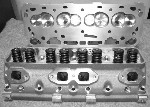|
Group: Forum Members
Last Active: Last Year
Posts: 927,
Visits: 190.0K
|
no indication of wher the basic casting came frome would not saticfy me,colt cams of langley bc went to the trouble of insureing ther cam blanks are cast in the us to his spec. i am not saying that is the case in all cams ,onley when 1 has consistent failures ther has to be a isue we are all missing. tho basice failure analisis tells a student you need all the facts, and the builder must have 1st axcess,frome oil analisis to tear down to establish probel cause. other wise one will most likeley miss the cause,frome base metal to profile to lifter finish ,to lifter material,to siting to long and pre lube.
just when we think we have the answer new evidence comes from the builder or asembler. it is not a exacting syence,just a learning curve. have to admit i have learned a bunch frome this syte. cliff
|
|
Group: Forum Members
Last Active: 5 Years Ago
Posts: 42,
Visits: 1.4K
|
Thank you John, When I remove the engine , i'll start checking for all these issues and get back to everyone here
|
|
Group: Forum Members
Last Active: 5 hours ago
Posts: 915,
Visits: 7.5K
|
Ted brings up a good point on the bronze valve guides. Bronze tends to need extra clearance as it seems to shrink for a few heat cycles. It eventually stabilizes. Check your ignition timing also, as Pat pointed out, too little advance will raise exhaust temperature and make the guide sizing more critical. We generally used K-Line style guide liners in Cast iron heads and set up guide clearance in the .002" intake and .0025" exhaust range. I would definitely have the guide clearances checked. As Pat pointed out the only oil on the cam/lifters is what is thrown off the rods. Check the side clearance between #2 and #6 rods. I would not run with less than .012". .015-.018" is better. All of the cam cores we see are CWC # 3358 B-S regardless of cam grinder. I have no indication that these are made off shore.
http://ford-y-block.com 20 miles east of San Diego, 20 miles north of Mexico 
|
|
Group: Forum Members
Last Active: 3 Years Ago
Posts: 3.0K,
Visits: 8.7K
|
I'm not sure most shops will be able to get to the tenths. Probably would stick with the .002 and .003 dimensions.
Frank/RebopBristol, In ( by Elkhart) 
|
|
Group: Administrators
Last Active: Yesterday
Posts: 7.5K,
Visits: 205.8K
|
Pushrod alignment within the holes in the heads is critical on the Y engines. If the pushrod is contacting the head, then camshaft/lifter failure becomes highly probable. The Isky 3/8” diameter pushrods brings this to the forefront but likewise if the rocker arms are not positioned correctly on the shafts. Look for wear marks on the pushrods. If you find some of these, then this is something that will need to be addressed. Pay particular attention to the #6 exhaust pushrod in your case.
  Lorena, Texas (South of Waco) Lorena, Texas (South of Waco)
|
|
Group: Forum Members
Last Active: 5 Years Ago
Posts: 42,
Visits: 1.4K
|
I'll have to give Mr. Mummert a call next week as he was the one who did my heads.
|
|
Group: Administrators
Last Active: Yesterday
Posts: 7.5K,
Visits: 205.8K
|
pegleg (2/14/2015)
And those clearances (new) should be? Mininum clearances for Y-Block stem/guide clearance with bronze guides in a racing application would be 0.002” for the intakes and 0.003” for the exhausts. For a street application this can be downsized to 0.0018” for the intakes and 0.0028” for the exhausts. Erring to the large side is always recommended where clearances are deemed critical.
  Lorena, Texas (South of Waco) Lorena, Texas (South of Waco)
|
|
Group: Forum Members
Last Active: 3 Years Ago
Posts: 3.0K,
Visits: 8.7K
|
And those clearances (new) should be?
Frank/RebopBristol, In ( by Elkhart) 
|
|
Group: Administrators
Last Active: Yesterday
Posts: 7.5K,
Visits: 205.8K
|
Adding to what Royce brings up, if the cylinder heads have had bronze wall guides installed, then even more additional valve stem to guide clearance is required. Stock iron head clearance values being used for bronze guides are simply too tight. If the guide clearances were not checked when heads went together, then the potential is there for inadequate clearance as there seems to be more variability in ‘new’ valve stem diameters now than in the past. Exhausts tend to give more problems in this area simply due to the higher heat loads placed on the exhaust stems.
  Lorena, Texas (South of Waco) Lorena, Texas (South of Waco)
|
|
Group: Forum Members
Last Active: 3 Months Ago
Posts: 658,
Visits: 16.7K
|
I would take a very hard look at the guide clearance on the exhaust valve where the failures occurred.. I remember a conversation with Mummert where he emphasized the need for additional clearance in Y Block guides above what most shops would normally provide... Ted may have an opinion also
|